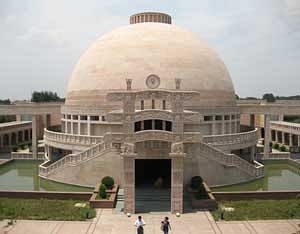
The temple is located at Luoyang, one of China's ancient capitals, in central China's Henan province. It is adjacent to the White Horse Temple (Baima Si) built in the first century A.D. in honour of two Indian monks who travelled on horseback, carrying with them religious texts and an image of the Buddha.
The idea of a temple was proposed by the Chinese in 2003 when then prime minister Atal Bihari Vajpayee visited Luoyang. He promptly accepted the idea, realising the importance of a Buddhist shrine as a means for people-to-people contact.
A Memorandum of Understanding was signed during Prime Minister Manmohan Singh's visit in 2008. The temple is ready for dedication May 27 as India and China celebrate 60 years of diplomatic ties.
India has provided technical, financial and other support for the temple that stands on a 6,000 sq metre plot provided by the Chinese government.
The construction task was assigned to New Delhi-based architects Akshaya Jain and Raka Chakravarty, who won an architectural design competition organised by the Ministry of External Affairs. Assisted by Kshitij Jain, the duo kept in mind that the design was to draw inspiration from the Sanchi Stupa with an idol of the seated Buddha in the preaching posture.
Sanchi in Madhya Pradesh is known for its Stupas, monasteries, temples and pillars dating from the 3rd century B.C. to the 12th century A.D. The most famous of these monuments, the Sanchi Stupa, was originally built by emperor Asoka.
The temple is Indian not only in concept and design but also the material that has gone into its construction. A variety of stones in many textures from Kota and Jaisalmer as well as marbles and granite were carried in 200 containers to China.
Jain and Chakravarty supervised the carving in India of each panel depicting episodes from the Buddha's life and Jataka tales before being transported to China.
"It has been five years of labour," the architects said.
Execution of the design involved several visits to the site over three years for supervision and detailed interaction - language constraint notwithstanding - with the Luoyang Religious Affairs Bureau and Foreign Affairs Office as also with the Chinese contractor responsible for the construction.
The temple has a dome 63 feet high and 80 feet in diameter. Its glass roof allows in a swathe of sunlight on the Buddha statue.
The statue, 15 feet high, is made of Chunar sandstone, the same that was used to make the fifth century Buddha idol at Sarnath in Uttar Pradesh.
At the entrance, there is 'toran' (the welcome gate) along with two 'dwarapals' (gatekeepers). There is a separate shrine for 'paduka', the Buddha's feet that are traditionally worshipped. Water bodies and lawns outside complete the exterior.
Although there are Buddha temples across China and in many parts of the world, an Indian-style Sanchi-inspired temple is the first one at Luoyang.